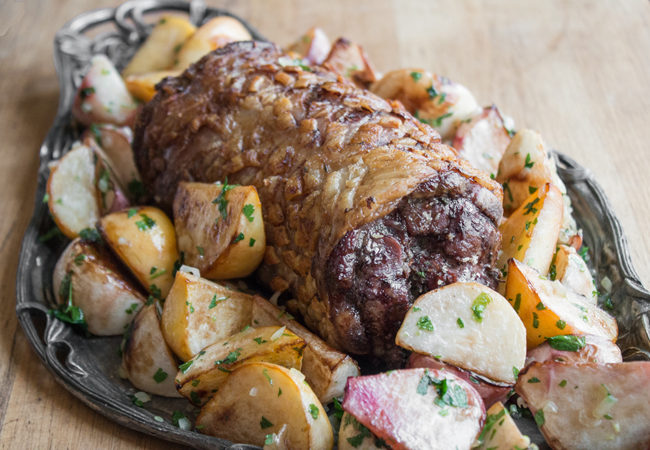
This story is sponsored by Shepherd Song Farm and written by Alan Bergo of Forager Chef.
There’s almost no better test of a home cook’s mettle than a large roast. Working with hefty sub-primal cuts like prime rib or leg of lamb (the subject of my previous piece) demands much stronger boning, roasting and carving skills than relying on pre-trimmed, conventional component parts like pork chops and beef tenderloin medallions.
But whatever sub-primals might ask of you, they return in spades: You get the ability not just to feed a large crowd, but also to wow them with an impressive display: That glorious hunk of roasted goodness emerging from the oven; the anticipation of that first, mouthwatering slice from the carving knife; that exquisite reveal of a perfect rosy interior framed by a brown, crispy, salty crust.
But let’s say you’ve already proven yourself with prime rib and leg of lamb. What’s next? Short of roasting an entire animal on a spit, how do you take your special-occasion cooking to the next level?
Here’s how: Roast up a whole saddle of goat or lamb.
What’s a saddle? Butcher specifications can vary a bit, but basically, the saddle of any animal is two whole loins, complete with the tenderloins that are on the other side of the bone. In reality, it is a what T-bone steaks look like in their sub-primal (whole-muscle) form.
If you took a cleaver to a goat or lamb saddle, you would end up with a bunch of small lamb or goat t-bone chops. But don’t start hacking away just yet…
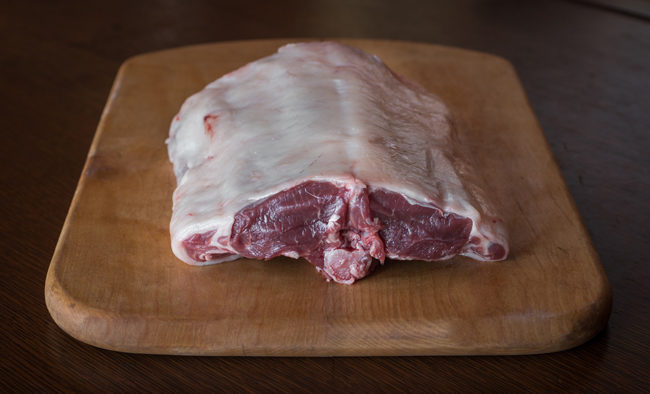
With their smaller size relative to beef and pork, creatures like lamb and goat share the special trait of being some of the only animals that have a whole saddle that can be cooked for a small group of people at home. One saddle of lamb will feed 8-10, and a goat about 4-6, while a saddle of beef would feed about 50-60, and require large cooking setups to prepare.
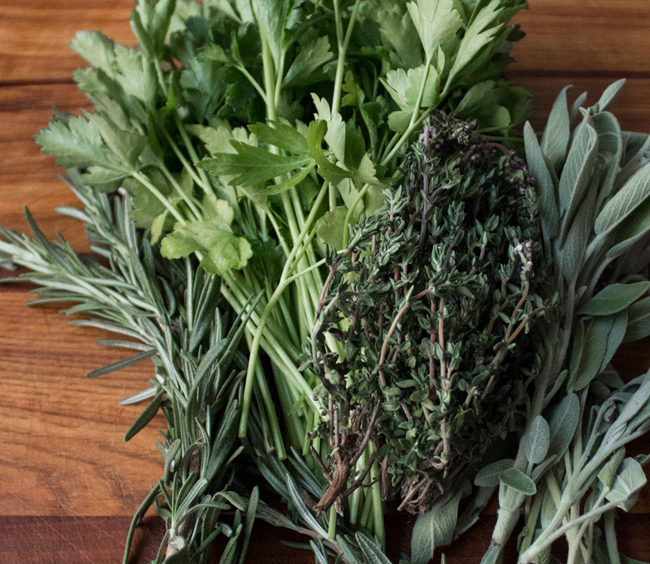
As meat roasting goes, cooking a saddle is pretty simple, but for easy slicing, it’s best to take out the backbone before you cook it. This also creates a cavity begging to be seasoned with a mix of fresh herbs. See below for a demonstration of removing the bone, and seasoning with fresh herbs and breadcrumbs.
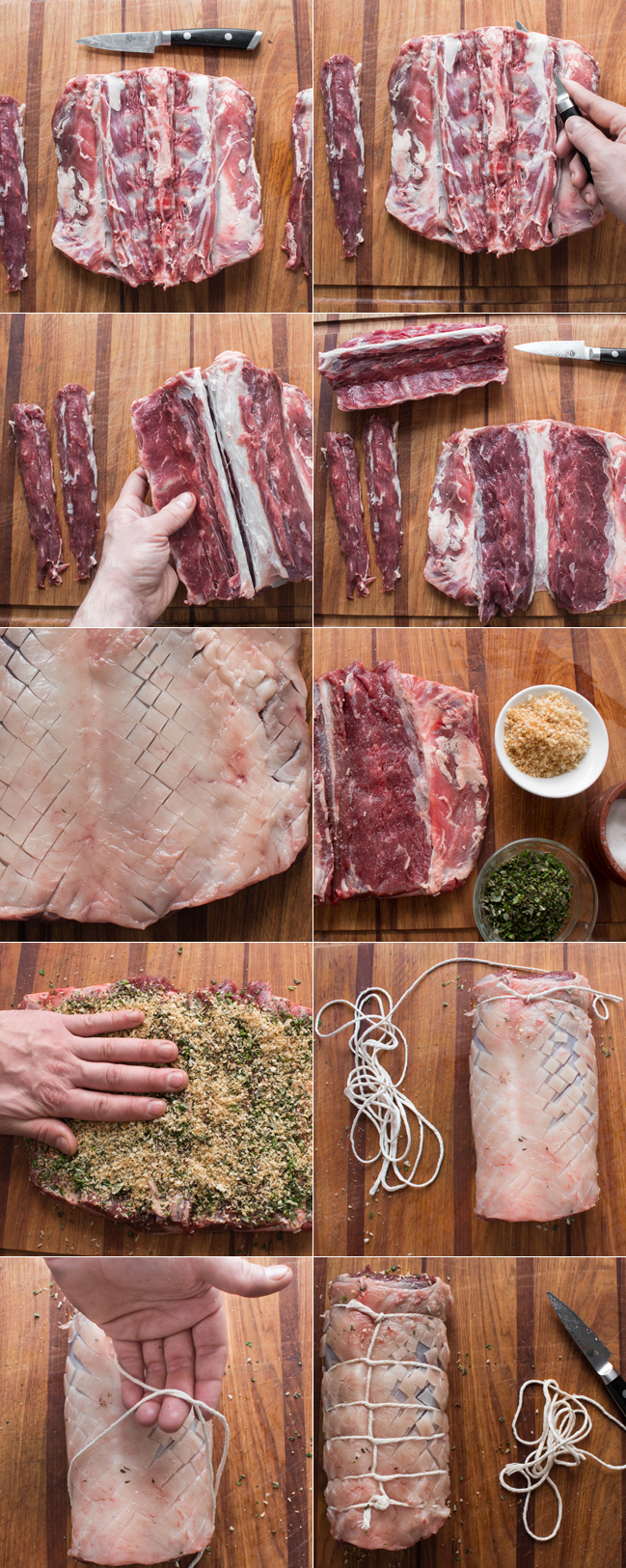
After your saddle is de-boned, seasoned and tied, it gets pan-seared, roasted or grilled to form a crackling crust, then cooked until medium or so, depending on your taste, then rested and sliced. Just like other roasts, there’s plenty of pan drippings for a great sauce, too — always a crowd pleaser.
For this basic recipe, I’m going to share a simple side of buttered turnips: an age-old partner to lamb and goat. If you have a local co-op, keep your eyes open for different varieties of turnips. Pictured are scarlet, gold, and purple-top, listed in order of the amount of sweetness each one has.
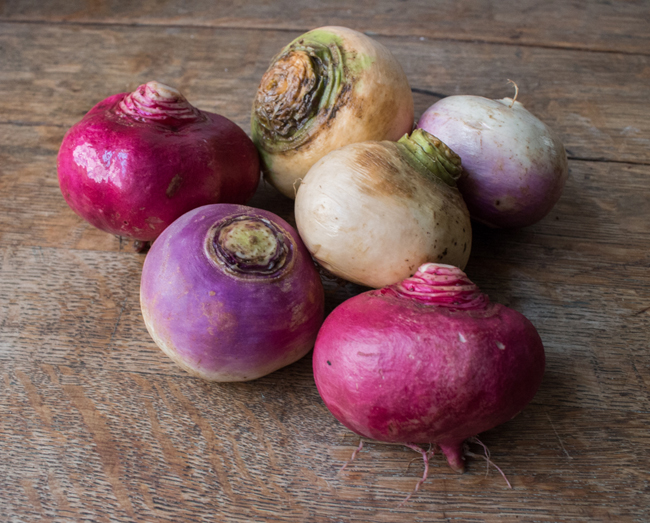
Back to the saddle. The tricky part about cooking a saddle isn’t the prep or execution. It’s finding a whole, high quality saddle to work with in the first place. Large cuts can be a hard sell at grocery or butcher shops due to their size and unit cost. Plus, with saddles, butchers can often get a higher price per pound by selling lots of smaller chops as opposed to one large piece, so they don’t hesitate to break those saddles down.
As a chef, when I’m in search of lamb or goat I look to my favorite purveyor: Shepherd Song. They ship around the country, and their 100% grass-fed product is the best I’ve tasted. Browse through cuts of their carefully selected heirloom breeds, and have them shipped right to your door at www.shepherdsongfarm.com
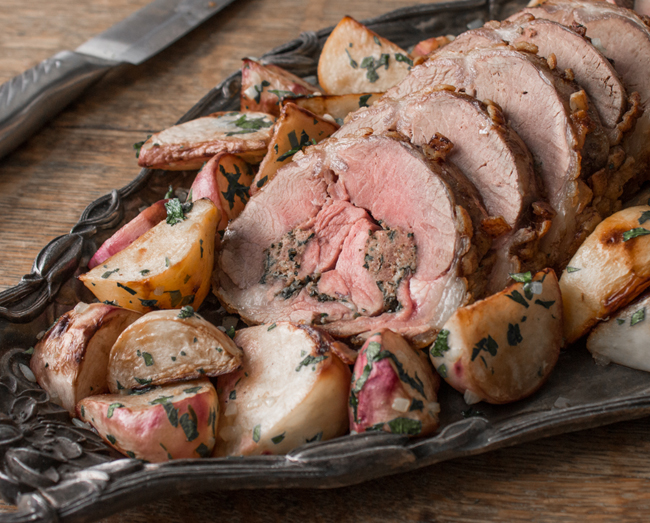
Herbed Goat or Lamb Saddle
This is a method for a roasted saddle and an optional side of buttered turnips. Serve with some cooked hearty greens or a salad for a complete meal.
If you don’t have a pan big enough to fit a saddle, you can brown it at 475F for 15-20 minutes, then reduce the heat to 250F until it’s finished cooking.
Equipment
• Sharp paring knife for removing the backbone from the saddle
• Butchers twine, for tying the roast
A goat saddle will serves 4-6 as an entrée, Lamb 8-10
Ingredients
• 1 whole lamb or goat saddle
• Kosher salt and fresh ground black pepper
• 2 ounces fresh herbs: I like a combination of equal parts rosemary, thyme, and sage, combined with some chopped Italian parsley, but other herbs like savory could also be used. You’ll need about 5 tablespoons of finely chopped herbs in total.
• 4 tablespoons toasted breadcrumbs, preferably panko
• 1 tablespoon flavorless oil, like grapeseed or canola, for searing
For the buttered turnips (optional)
• 2.5 lbs turnips, the smallest you can find, peeled and cut into wedges, if the turnips are very large they could also be diced into cubes.
• 2 tablespoons roughly chopped Italian parsley
• 3 tablespoons unsalted butter
• Kosher salt and fresh ground black pepper
• ¼ cup finely chopped shallots
Method
Prepping and seasoning the saddle
1. Before you remove the backbone from the saddle, put a small handful of rosemary, thyme, sage and parsley on the cutting board and chop all of the herbs together at the same time until fine. Reserve the herbs for seasoning the saddle.
2. Referring to the pictures above, remove the backbone from the saddle, score the fat side in a crosshatch pattern lightly to help the fat render, then season on both sides with salt and pepper.
3. Lay the saddle fat side down and season with the chopped herbs, then the toasted breadcrumbs. Press the mixture down on the meat to help it adhere, then roll it up tightly, seam side down.
4. Tie the saddle tightly with butchers twine to ensure even cooking. Allow the saddle to come to room temperature before you start to cook it.
Cooking the saddle
1. Preheat the oven to 250º F
2. Heat the tablespoon of oil in a large skillet or cast iron pan (a 12 inch pan will fit
a goat saddle). Turn on the oven hood, a fan, or open the window, as searing can make a little smoke and possibly set off your fire alarm.
3. When the pan is hot, sear the saddle deeply all over,about 10-15 minutes, removing fat from the pan as it renders that you can use to cook the turnips, if using. Either way, I like to remove fat as it gathers in the pan while searing to help cut down on any smoke.
4. When the saddle is deeply browned, place it in a roasting pan on a rack, or on top of some carrots or vegetables so the meat doesn’t directly touch the pan, which can cause the bottom to cook faster than the rest of the roast.
5. Cook the saddle in the oven until a thermometer reads 135, which will come out around medium from the low temperature cooking. Allow the saddle to rest in a warm place while you prepare the turnip, if serving.
Preparing the turnips (optional)
1. Increase the heat of the oven to 375º F
2. Put the rendered lamb fat in a large pan and heat until just smoking. Add the turnip wedges, season with salt and pepper to taste, then cook until browned, stirring occasionally, about 5-10 minutes. If needed, transfer to turnips to the oven to finish cooking.
3. When the turnips are just tender, add the shallots, and butter to the pan and stir to combine. Cook the turnips for 2 minutes more, double check the seasoning for salt, adjust as needed, then finally toss with the parsley and keep warm while you carve the saddle.
Carving and serving
When the turnips are done, transfer the saddle to a cutting board and slice with a sharp knife into 1 inch slices. Arrange the sliced saddle on a warmed platter surrounded by the turnips and serve immediately.
